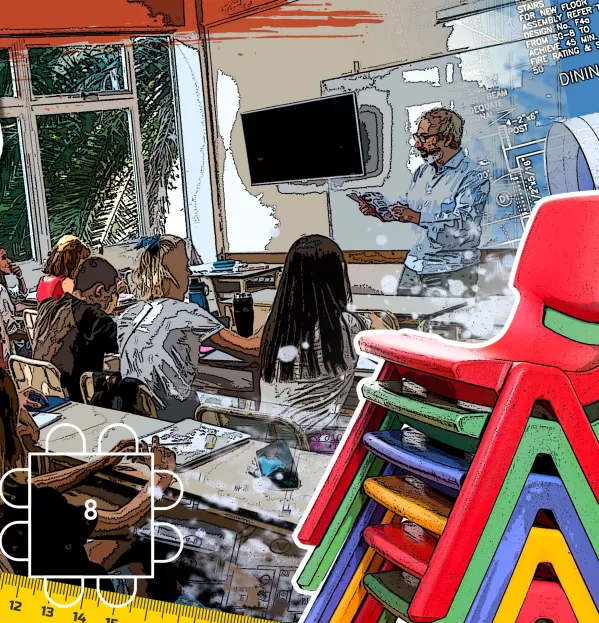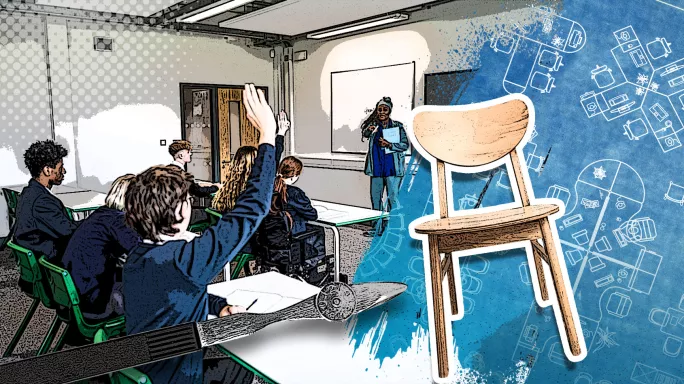- Home
- Teaching & Learning
- General
- How to make sure your classroom helps, not hinders, learning
How to make sure your classroom helps, not hinders, learning

“In one school I worked in, we used to have the hot side of the street and the cold side of the street,” says Anne Williams. “In winter, you did not want to be on the cold side, but when the summer came, you could hardly teach on the other side because it was so hot.”
Williams is a secondary English teacher, and she is not alone in recognising the problems with school buildings. Everyone in the sector knows about them. In fact, in its annual report, published last month, the Department for Education said there was a “worsening” risk of some buildings outright collapsing.
Both the government and Labour want to do something about this. In December, the DfE announced that 239 school buildings would be transformed as part of a 10-year programme to improve facilities, and that any new buildings will be more energy efficient for future winter resilience. Labour, meanwhile, has pledged to invest £7 billion in ensuring that “all school buildings are safe”.
It isn’t just a lack of structural integrity or energy efficiency making classrooms less conducive to learning, though. Research shows that multiple other factors, including the amount of light and the layout of the desks, can affect student outcomes.
In 2015, researchers at the University of Salford published a large study looking at just how much of a difference these factors make. The researchers assessed 153 classrooms from 27 primary schools and analysed the impact of different classroom designs. They found that being in a “well-designed” classroom boosts learning significantly.
“We know that 70 per cent of the variation in learning is because of the characteristics of individual children. Of that remaining 30 per cent, 16 per cent was because of differences in classroom design,” says Peter Barrett, an emeritus professor at Salford, who led the research.
Working together with sense specialists and neuroscientists from the Salk Institute for Biological Studies in the US, Barrett and colleagues determined that there are seven “practical design parameters’’ that influence learning, including air quality, light, temperature and flexibility within the space. The parameters had different levels of influence: light was the most important at 21 per cent, followed by ownership at 17 per cent. And while it was “rare to get everything ‘wrong’ in one space”, Barrett found that when an average pupil was put through a “theoretical calculator”, which saw all seven parameters suffer, their progress was 1.3 sub-levels lower than if they’d been in the perfect classroom.
“They’re only expected to make two sub-levels’ progress in the year, [so] if you’re in a cramped, hot, noisy, stuffy classroom, it can really, really affect your capacity to learn,” he says.
Many teachers would say that the qualities that make a good classroom environment are no great mystery; the big problem is having the money to make this environment a reality. Headteachers are currently struggling to pay their schools’ energy bills, let alone fund a classroom revamp - and while the DfE’s new building transformation plan might be a step in the right direction, it isn’t a blanket offer to all schools.
So, how can teachers set up their classrooms to maximise learning right now, without their school having to fork out thousands for a full redesign?

Find the balance with displays
For Year 4 teacher Emma Train, display boards and working walls are the most important elements of her classroom environment.
“Each classroom should have English, maths and reading working walls. They are absolutely key because they support children in their learning and help them to become more independent,” she says.
Research suggests, though, that teachers need to be careful about the nature of those displays.
In 2014, Anna Fisher, a professor of psychology at Carnegie Mellon University in the US, conducted a study that compared children’s learning in two classroom environments: one that had brightly coloured charts, resources and art on the walls and one that had bare walls. She found that learning was better in the latter, because of the reduced demands on children’s attentional capacity.
Does that mean that displays should be totally avoided? Train doesn’t think so. While she acknowledges a stripped-back approach can be less distracting, she still feels it’s important to make classroom resources visible and engaging.
“I don’t tend to have a lot of bright stuff behind me at the front of the classroom where I’m teaching because, ultimately, I want them to be focusing on me,” she says. “But I have displays that show handwriting formation, and the times table we’re learning that week, because they are always looking in that direction.”
‘In every design decision, teachers should ask: what learning activity will this enhance?’
Indeed, according to the Clever Classrooms report, produced by Barrett and his team, there’s no need for teachers to forgo displays completely. They advise using them to make the classroom feel more “lively” without it “becoming chaotic” and, as a rule of thumb, suggest keeping 20-50 per cent of wall space clear.
The report also recommends that “given that a mid-level of stimulation is sought for an effective learning environment”, teachers should assess the existing amount of colour in the room before introducing any brightly coloured displays.
“The aim is to increase stimulation against a muted background, or calm the feel if it is already rather bright,” the researchers explain.
According to Murray Hudson and Terry White, experts in classroom design and the authors of Planning Learning Spaces: A Practical Guide for Architects, Designers and School Leaders, learning must be the driving force behind every choice a teacher makes about their classroom setup - including around displays.
“In every design decision, [teachers] should ask: what learning activity will this enhance? For example, we know notice boards are important, but the learning purpose often isn’t considered,” says White. “Are you going to bring children around that wall, and do you have the space to do so?”
Maximise flexibility
White and Hudson also suggest that teachers should consider which elements of their classroom need to remain fixed, and which can be flexible.
For example, having a reading corner may be non-negotiable, particularly in primary schools. Teachers may also feel it is essential to have an area that can be acoustically controlled and used for quiet work, or interventions (such as with children with special educational needs or disabilities). For one school White and Hudson worked with, creating that space meant repurposing a cloakroom area in the corner to become a space where pupils could have quiet reflection time while remaining part of the class.
Once you have established what you want these fixed elements to be, they add, you can start work on the elements that can be more flexible. And, as research shows, making the classroom environment flexible can have all kinds of benefits.
In 2017, for example, Ann Gansemer-Topf, an associate professor at Iowa State University, conducted research into the effect of an active learning classroom (ALC), which was designed specifically to facilitate collaborative learning, with portable whiteboards, supplemental computer monitors and flexible seating to accommodate small-group, large-group and individual work.
The researchers found that “the flexible, open design of the ALC allowed for movement within the classroom, encouraging social interaction among peers, students and instructors. Participants reported that frequent social interaction enabled students to connect with each other and their instructor to share, distribute and co-construct knowledge, resulting in a feeling of community and engagement”.
Making sure that your space supports different types of learning can be a really good thing, then - and, according to Barrett’s report, there are some simple ways to do this. Dividing the room into clear “zones” is one option.
He explains that younger pupils, in particular, “need many well-defined zones for varied learning activities at the same time, eg, carpet area, reading corner, PC corner, role play, wet play, teacher station, etc”. Older pupils will also benefit from the use of zoning, but they will likely require fewer zones - resulting in “simpler space configurations” that “support more formal individual or group work, without cluttering the classroom unduly”.
Create a sense of ownership
A more flexible space lends itself to independent learning, but you don’t need to rely on multiple zones to facilitate this, White points out. Creating a sense of autonomy can be as simple as ensuring that pupils can reach resources themselves without having to rely on the teacher.
“If you’re handing out stuff, you’re controlling everything and giving the pupils no opportunity to help the learning. Resources that can be in a trolley, moved about, put to one side and brought out into the space are really important,” he says.
Barrett agrees that it’s crucial pupils feel a sense of ownership over their room and, in his report, sets out some other ways to go about this. He points out that, while there is a balance to strike with wall displays, presenting pupil-created work around the room “is more likely to provide a sense of ownership”.
“The classroom can be made readily recognisable from others by distinctive class-made displays,” the Clever Classrooms report states.
Finding opportunities for pupils to “personalise aspects of the classroom, for example, named lockers or drawers” is also a good option.

Consider layout of desks and other furniture
As a primary supply teacher working in London, Jack Parrett sees a lot of classrooms - and, for him, the layout of the desks often makes the biggest impact on teaching and learning.
“Seating arrangements have so many effects on how pupils engage with and inhabit the classroom,” he says. “Where they are in the class can present physical barriers to learning resources.”
“The layout can impact how a teacher circulates around the room and who they interact with most regularly,” he adds.
Research on which desk layout is most conducive for learning is limited. Indeed, in 2008, Rachel Wannarka and Kathy Ruhl, both researchers from Pennsylvania State University, found just eight studies in the previous 28 years that compared at least two of three common seating layouts: rows, clusters and a U-shape.
Wannarka and Ruhl concluded that, generally, teachers who want to maximise the on-task behaviour of their students during independent work should consider rows rather than groups as their primary seating arrangement. When interaction is desired, however, desks should be moved into other positions.
‘Teachers don’t want big, fancy classrooms. They just want the money to be put into the basics’
According to Hudson, if schools have the money to invest in new furniture, they can be creative here. For instance, having triangular-shaped desks on wheels (which can come together to form all sorts of shapes) allows teachers more freedom over their layout, making it easier to change from rows to clusters for group work.
Furniture can also be multifunctional, he adds; some of the schools he has worked with have purchased wipe-clean desks that children can write directly on to, like a whiteboard.
Seating, meanwhile, can be used to support zoning: as well as traditional chairs, you might have bean bags in one area and bar stool-type chairs in another.
Manage environmental factors as best you can
Barrett’s report found that environmental factors such as light, air quality and temperature all affect learning. However, these can be some of the hardest factors for individual teachers to control.
The Clever Classrooms report does offer some advice, though.
To maximise natural light, avoid placing display materials on windows - particularly external ones - or positioning large items of furniture in front of them. If, on the other hand, too much light is coming in (because your room is south facing, for example), putting shrubs or planters outside the windows can block some of that light.
In terms of air quality, the report says that carbon dioxide monitors can be helpful tools to indicate when teachers might need to take steps to improve the air in their rooms. In 2021, as part of Covid-19 measures, the government announced that monitors would be provided to all state schools from September 2021.
Whether you have a CO2 monitor or not, the report says that, in a typical classroom with 30 pupils, it will normally be necessary to open a window during a lesson. If not practical, opening the windows between classes is strongly recommended.
Opening windows can also help you to control the temperature of the room. According to the report, the optimum temperature for learning is between 18C and 21C, so this is what you should set your thermostat to if you have one in your room.
Ultimately, though, Train argues that all the savvy design choices in the world can’t make up for classrooms that lack the fundamentals - such as proper heating.
“Teachers don’t want big, fancy classrooms, which actually can distract children from their learning. They just want the money to be put into the basics,” she says.
Williams agrees: “Teachers don’t want the most amazing classrooms of all time. I’d go for simplicity any day. I want the tech to be good and reliable, I want mini whiteboards, I want chairs to be comfortable, I want a desk to be big enough for pupils to put their stuff on and extra desks within the room,” she says.
“The shiny new things really don’t matter when you haven’t even got the basic necessities.”
So, while there might be a link between classroom design and teaching and learning - and while many design choices are within teachers’ control - that doesn’t mean the campaigning for buildings that simply get the basics right can stop any time soon.
Register with Tes and you can read two free articles every month plus you'll have access to our range of award-winning newsletters.
Keep reading with our special offer!
You’ve reached your limit of free articles this month.
- Unlimited access to all Tes magazine content
- Save your favourite articles and gift them to your colleagues
- Exclusive subscriber-only stories
- Over 200,000 archived articles
- Unlimited access to all Tes magazine content
- Save your favourite articles and gift them to your colleagues
- Exclusive subscriber-only stories
- Over 200,000 archived articles
topics in this article



